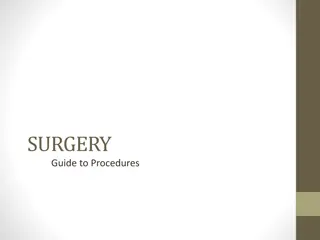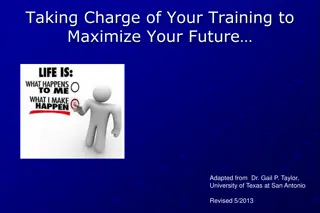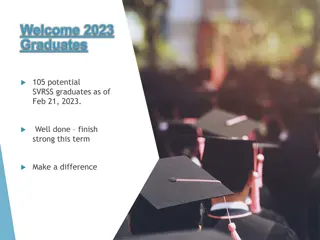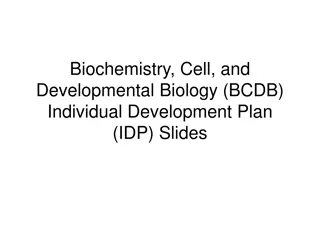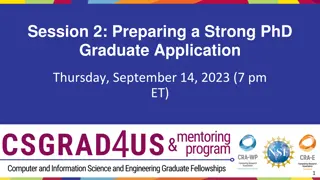PREPPING FOR GRAD SCHOOL
In this narrative, Kelly M. Kidwell, PhD, shares her journey from undergraduate to graduate school, focusing on her decision-making process, experiences, and opportunities in the field of biostatistics at the University of Michigan and University of Pittsburgh. She discusses her path from mathematics and science love to pursuing a PhD, offering insight into application requirements, research opportunities, funding choices, and more along the way. Through anecdotes and reflections, she provides valuable guidance to those considering or navigating graduate school.
Download Presentation

Please find below an Image/Link to download the presentation.
The content on the website is provided AS IS for your information and personal use only. It may not be sold, licensed, or shared on other websites without obtaining consent from the author.If you encounter any issues during the download, it is possible that the publisher has removed the file from their server.
You are allowed to download the files provided on this website for personal or commercial use, subject to the condition that they are used lawfully. All files are the property of their respective owners.
The content on the website is provided AS IS for your information and personal use only. It may not be sold, licensed, or shared on other websites without obtaining consent from the author.
E N D
Presentation Transcript
Kelley M Kidwell, PhD PREPPING FOR GRAD SCHOOL July 22, 2019 University of Michigan BDSI 1
OUTLINE About me Degree options Application requirements Biostatistics at University of Michigan Things to remember if you go to grad school 2
ABOUT ME 3
INTRODUCTION TO MY LOVE OF MATH Mrs. Roberson Mrs. Gottschalk 5
MATH + SCIENCE = ENGINEERING? No, MATH+SCIENCE = MATH Logic, sets and What? Where did the numbers go? Another Teacher- Professor Gorkin 6
HOMEWORK If any teacher has had an impact on your path, let them know! 7
SUMMER OPPORTUNITIES Actuary Internships Math Camp for Girls: Summer Program for Women in Mathematics, 2006 Mathematical Biology Graduate School 8
GRADUATE SCHOOL DECISION Applied in Fall of my senior year in college to several graduate programs for a PhD Research programs online Email students currently in program Visit open house or accepted students day 9
MY GRADUATE SCHOOL DECISION I applied right out of undergrad acceptances to masters programs, but only 2 directly into PhD Visit programs Current students Research opportunities Stipend Geographic location 10
GRADUATE SCHOOL University of Pittsburgh, PhD in Biostatistics Enrolled: 2007 Graduated: 2012 No official masters Decision: funding, feel of program, research opportunities, proximity to family Research Opportunities: teaching assistant, graduate student researcher 11
JOB Applied nationwide to academic and pharmaceutical jobs Went to many interviews Ultimately decided to come to University of Michigan in Fall of 2012 Excellent Biostat Department Ann Arbor Husband had a great offer in Psychology 12
PROGRAMS YOU MAY CONSIDER Statistics- theory, testing, estimation Biostatistics- develops and applies statistics to design and analysis of studies in public health and biomedical research ComputerScience- artificial intelligence, chip design, databases and data mining, computation theory, large scale and parallel systems, algorithms, machine learning Bioinformatics (Computational Medicine)- computer science, algorithms, databases and structures, data storage- added biology and statistics knowledge Data Science- dealing with data , algorithms, machine learning, large databases, visualizing data 14
GOOD DEGREES Fortune Magazine and Payscale reported that a doctorate in statistics leads to a career with lower stress List of Best Graduate Degrees PhD in Statistics is #1 Master s in Biostatistics is #2 Master s in Applied Math is #8 Master s in Statistics is #9 15
DEGREES LEAD TO JOBS According to Glassdoor (number of openings, salary and overall satisfaction rating) #1: Data Scientist #3 Data Engineer #5 Analytics Manager #33 Professor Forbes 2016: With the explosion of big data and the need to track it, employers keep on hiring data scientists. But qualified candidates are in short supply. The field is so new, the Bureau of Labor Statistics doesn t even track it as a profession. Yet thousands of companies, from startups that analyze credit card data in order to target marketing and advertising campaigns, to giant corporations like Ford Motor and Price WaterhouseCoopers, are bringing on scores of people who can take gigantic data sets and wrestle them into usable information. As an April report from technology market research firm Forrester put it, Businesses are drowning in data but starving for insights. 16
MULTITUDE OF CAREER OPTIONS Wealth of opportunities Academia Hospitals Research centers Government Pharmaceutical companies Tech companies Other industry 17
JOBS: WORK IN BUSINESS Organizations focus on finding 2 sport data athletes that bridge areas: combinations of computer programming, statistics, psychology, economics, finance, etc 18 http://www.mckinsey.com/business-functions/marketing-and-sales/our-insights/big-data-help-wanted-badly-how-to-win-the-war-for-talent
SCHOOLS WITH BIOSTATISTICS PHD University of Michigan Columbia Medical University of South Carolina Emory Harvard Virginia Commonwealth University UC Berkeley University of Washington University of Minnesota Tulane University of North Carolina University of Wisconsin Boston University Johns Hopkins University University of Texas Health Sciences Center Medical College of Wisconsin University of Pennsylvania University of Buffalo Vanderbilt University of Cincinnati Iowa University University of Pittsburgh 19
SCHOOLS WITH OTHER PROGRAMS Statistics: https://www.usnews.com/best-graduate-schools/top- science-schools/statistics-rankings Data Science: http://datascience.community/colleges Computer Science: https://www.usnews.com/best-graduate- schools/top-science-schools/computer-science-rankings Bioinformatics: https://www.iscb.org/iscb-degree-certificate- programs 20
BIOSTATISTICIANS Develop and apply novel statistical designs and methods for answering scientific questions Participate in cutting-edge biomedical research Apply mathematical skills and logical thinking to important problems in many areas of research Varied and stimulating career Clear quantitative thinkers are in high demand 21
WHAT ARE WE DOING AT UM? Design life-saving systems to prioritize who gets organ transplants Unravel genetic basis of human health and disease Design and analyze data from clinical trials for new drugs Build models that predict cancer recurrence Test effectiveness of behavioral interventions for smoking cessation and obesity 22
GRADUATE DEGREES MS MPH PhD Funding: not all programs offer funding for students, especially masters programs 24
ADMISSION TO PROGRAM Math background and grades GPA GREs Recommendation letters Statement of purpose Course Pre-reqs Useful courses: advanced calculus, other math and statistics, computer science 25
GRADUATE SCHOOL APPLICATIONS Online Start looking early and organize Statement of purpose Letters of recommendation Fees Due date Apply to many programs/schools if possible Application fee Contact administration/professors/students at programs of interest 26
CLASSES AND GRADES Good undergraduate GPA More important for related courses to be high than overall high If you have low grades in statistics, mathematics, or computer science courses, you may want to explain circumstances in your cover letter Take mathematics and statistics courses Take a few related graduate courses if available Courses related to your field and related programs are more important than many extra-curriculars 27
GRE General GRE required for most programs, occasionally subject specific GRE also required Use of these is complex and varies across programs e.g.: UNC: average incoming students 72nd %ile verbal and 89th %ile quantitative Aim as high as possible in all areas: Quantitative, Verbal and Writing Study/prepare Take more than once if needed Schedule with enough time to take again 28
LETTERS OF RECOMMENDATION Usually 3 letters required Choose wisely More than you attended their class and did well Visible and senior people in field At least 2 in related field Meet with a handful of professors and discuss the potential of graduate school with them Do you think I m well suited for grad school? Do you think I ll be admitted and successful to these programs? Provide these professors with your personal statement and transcript 29
STATEMENT OF PURPOSE a concise, well-written statement about your academic and research background, your career goals, and how this graduate program will help you meet your career and educational objectives Often students write about how they fell in love with math/stat How are you unique? Effective to write in a concrete way about what you want to be doing in 10 years- are your goals aligned with the program? Reflect on what is most pertinent to how you developed these goals- research experience, coursework, internships 30
STATEMENT OF PURPOSE Avoid generic sentences: I love statistics, I am interested in research Every sentence contain specifics about you If multiple tracks in a program, delineate your interests Why this particular school/program? Have many people read and give feedback 31
DURING AND AFTER APPLICATION Research online Email faculty and students currently in program Visit open house or accepted students day Ask about funding for this 32
BIOSTATISTICS PROGRAM University of Michigan 33
DEGREES: MASTERS: 2 YEARS MS: Masters in Science 2 years, 48 credits 22 credits (6 courses) core biostat courses 12 elective credits in biostat or stat Open electives Epidemiology requirement 1 credit Public Health course MS Health Data Science Concentration: additional core courses MPH: Masters in Public Health Similar to MS Breadth and integration of knowledge- 3 PH related courses at least 2 credits each (one in epi and other from other depts., not biostat, stat or math) Internship- 8 weeks during summer after first year 34
MASTERS REQUIREMENTS https://sph.umich.edu/biostat/programs/masters.html Bachelor s degree General GRE exam within last 5 years Competency in English if not native language (TOEFL or MELAB) 3 semesters calculus, matrix or linear algebra, intro statistics or biostat course Less prep may be conditionally admitted 35
MASTERS COURSEWORK Probability theory, statistical inference Applied sequence linear regression generalized linear models longitudinal analysis Capstone course: Analysis of biostatistical investigations 36
DEGREES: PHD: 5-6 YEARS https://sph.umich.edu/biostat/programs/phd.html With Masters 13-19 additional credit hours of core biostatistics courses (6 courses) 15 credit hours electives in biostat/stat Epi requirement 1 credit Public Health requirement 7-10 credits: Open elective requirement Without Masters 34 credit hours of core biostat course (12 courses) Elective, Epi, PH, and open electives same as above Qualifying Exams: ~after year 2 6 hour theory exam 6 hour applied exam 37
PHD REQUIREMENTS https://sph.umich.edu/biostat/programs/phd.html Previous masters degree or strong candidates with bachelor s degree General GRE exam within last 5 years Competency in English if not native language (TOEFL or MELAB) 3 semesters calculus, matrix or linear algebra, intro statistics or biostat course Less prep may be conditionally admitted 38
PHD COURSEWORK Same as masters Advanced inference Stochastic Processes Other courses Survival analysis Clinical trials Time series High throughput analysis Bayesian inference Nonparametric statistics Categorical data Population genetics Spatial statistics Missing Data Special topics courses 39
PHD DISSERTATION Work with one or more faculty mentors Creative and significant original contribution to the field of biostatistics Development and evaluation of biostat methodology 3 loosely related papers to be of publishable quality or one in- depth look at a topic Dissertation committee of faculty Propose dissertation with a presentation within 2 years of becoming a PhD candidate Defend dissertation with a presentation open to the public 40
THINGS TO REMEMBER IN GRAD SCHOOL 41
CHOOSING AN ADVISOR Challenging, intelligent, passionate, helpful Worked in novel and interesting area 42
GRADUATE SCHOOL Work ethic Work hard, engage with faculty & other students Take advantage of opportunities Go to conferences Have fun, seek balance 43
IN REVIEW Start preparing now if you are interested in graduate school- do your research Remember you ve chosen the path, so enjoy it and find balance Seek out mentors and let them influence you Thank your mentors Exciting, marketable field 45
THANK YOU kidwell@umich.edu 46
MY RESEARCH 47
MOTIVATION Setting: Treatment of Chronic Diseases Problem: Discrepancy between how treatment is practiced and how treatment is studied 48







